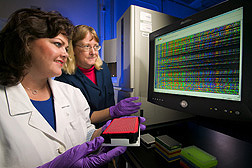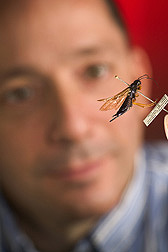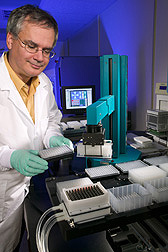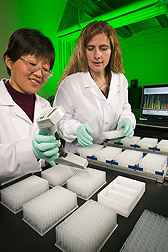A Wealth of Genetics Technology Under One Roof
|
|
Genomics research is a rapidly evolving field that requires expensive and sophisticated equipment. The USDA Mid South Area Genomics Laboratory (MSAGL) was formed in 2000 to meet the genetic-sequencing needs of 14 research locations in a 5-state region. Crops under study include cotton, soybeans, rice, sugarcane, and catfish.
The Stoneville, Mississippi, laboratory houses several high-throughput DNA sequencers, robotics, bioinformatics computers, and other equipment, with an estimated value of $2 million. This makes it the largest genomics facility within ARS.
Brian Scheffler, a computational molecular biologist in the Catfish Genetics Research Unit (CGRU) at Stoneville, heads the genomics lab, located at the Jamie Whitten Delta States Research Center. He says the lab is specially equipped to handle DNA sequencing and fragment analysis for marker-assisted breeding.
“Support is provided to Mid South Area scientists at a cost significantly less than what is available to them on the open market,” Scheffler says. “This lab also acts as a technology-transfer facility, helping to incorporate molecular techniques into ongoing research programs that have not traditionally used them.
“Much of the genomics research in the public sector focuses on increasing our basic understanding of biological functions,” Scheffler explains. “This type of research also takes place in the Mid South Area. But we’re using the technology in ways that have a direct impact on real, everyday problems, like helping provide U.S. producers with new ways to protect their crops or increase yields and thus secure their place in world markets.”
|
|
Markers Make It Easy
All living things are made of cells, and all of them have DNA, which carries their genetic information. It’s Scheffler’s job to help researchers tap into the genetic information of whatever species they are studying to find solutions to agricultural problems.
To identify the gene responsible for a disease or trait, researchers use genetic landmarks known as “DNA markers,” which can tell them roughly where the gene is on the chromosome. A marker can be a gene, or it can be a section of DNA with no known function. DNA segments that lie near each other on a chromosome tend to be inherited together; so markers can be used indirectly to track inheritance pattern of genes that have not yet been identified but whose approximate locations are known. Markers can also be used to create a fingerprint to help identify varieties.
For example, the ARS Sugarcane Research Unit in Houma, Louisiana, has been working very closely with the genomics lab to develop new sugarcane varieties. Sugarcane is an important commodity, not only for sugar production, but also as a bioenergy source. The task is complicated because it is difficult to determine whether seed is the result of a cross with the desired male parent or of self-fertilization. The genomics lab partnered with the sugarcane unit to adapt a high-throughput DNA fingerprinting method to confirm parentage of seedlings. Scheffler says this method will improve breeding efficiency, since they can discard the undesirable, self-fertilized ones before planting.
|
|
In a unique application, a bacterial artificial chromosome (BAC) fingerprinting technique was adapted for high-throughput analysis by Sylvie Quiniou, a CGRU molecular biologist, in conjunction with MSAGL. A private firm and university researchers are currently following her lead and using this BAC fingerprinting technique.
“A high-throughput system for isolating quality BAC DNA is often a necessary step for constructing genome maps,” Scheffler says. “The BAC physical map will be a useful tool for identifying genes that affect production traits and could act as the backbone for future efforts to sequence the catfish genome.”
After larvae suspected to be Sirex noctilio, an exotic woodwasp, were discovered in upstate New York, entomologist Nathan Schiff and plant pathologist A. Dan Wilson, who are with the USDA Forest Service’s Center for Bottomland Hardwoods Research in Stoneville, contacted Scheffler at MSAGL. Using DNA sequences, they identified the larvae as S. noctilio. Several months later, when adult wasps emerged, the DNA identification was confirmed. This woodwasp is considered a major threat to U.S. paper and timber industries, especially in the Southeast, because it could cause extensive damage to North American pines. The ability to identify infestations before adults emerge will be invaluable for early detection and control of S. noctilio.
MSAGL staff also teamed with geneticist Jodi Scheffler, in ARS’s Crop Genetics and Production Research Unit at Stoneville, Clemson University in South Carolina, and grower-funded Cotton Incorporated to develop a DNA marker database for cotton. The lab tested more than 700 molecular markers on diverse cotton varieties and species, which will benefit commercial and public-sector breeding programs.
|
|
Tagging Cotton
The lab also assisted Earl Taliercio, a molecular biologist in the Stoneville crop genetics lab, in determining 70,000 expressed sequence tags (ESTs) from upland cotton ovules, young fiber stems, and roots. ESTs—short sequences of DNA—greatly reduce the time required to locate a gene. The goal is to understand when, where, and how a gene is turned on, a process known as “gene expression.” This work will help ARS develop better cotton varieties for producers and will significantly increase the number of upland cotton ESTs in the public domain.
Other projects being tackled at the lab include development of molecular markers to identify crepe myrtle, dogwood, and hydrangea varieties in nurseries.
Scheffler says the lab’s success is due to several key factors.
“Our stakeholders appreciate and want the technology applied to their problems,” he says. “We have strong administrative support to maintain the operation of the facility, and my staff is composed of excellent and dedicated individuals. But the most important factor is the scientists who use our facilities. Their projects and creative ideas are the backbone of the lab’s success.”—By Jim Core, formerly with ARS.
This research is part of Plant, Microbial, and Insect Genetic Resources, Genomics, and Genetic Improvement, an ARS National Program (#301) described on the World Wide Web at www.nps.ars.usda.gov.
Brian Scheffler is in the Catfish Genetics Research Unit, Jamie Whitten Delta States Research Center, 141 Experiment Station Rd., Stoneville, MS 38776-0038; phone (662) 686-5454, fax (662) 686-5372.
"A Wealth of Genetics Technology Under One Roof" was published in the July 2006 issue of Agricultural Research magazine.










